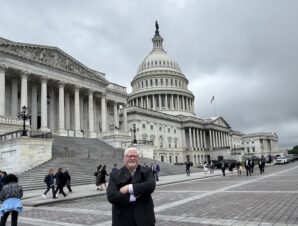 Dain Hansen is vice president of Government Relations, The IAPMO Group. He lends his frequent perspective of Capitol Hill, and the plumbing industry.
Dain Hansen is vice president of Government Relations, The IAPMO Group. He lends his frequent perspective of Capitol Hill, and the plumbing industry.
Here is an edited version of his update from July 30, 2021:
Congressional Update.
Finally, an Infrastructure Bill. The House passed an infrastructure bill Thursday that would direct more than $700 billion over five years for roads, railways, electric vehicles, and water, with Democrats set to use the policy to negotiate on a broader infrastructure package. The bill (H.R. 3684), passed in a largely party-line vote of 221-201, faced opposition from Republicans who criticized climate provisions and a lack of funding measures. The passage comes a week after a bipartisan group of senators and President Joe Biden agreed on a separate, nearly $1 trillion infrastructure framework that includes baseline spending.
But combining the proposals and coming to an agreement on how to pay for the legislation will be a heavy lift. Several authorizing committees in both chambers have jurisdiction over infrastructure, with different ideas for how to implement policy. Adding to the urgency is a Sept. 30 deadline to reauthorize surface transportation programs, regardless of whether a larger infrastructure deal is cut. DeFazio said the House bill and Senate bipartisan agreement are “within shouting distance” on spending levels, but that the Senate proposal is only a broad outline that lacks any detailed policy proposals.
The House measure includes historic levels of investment for drinking and wastewater infrastructure. The legislation would authorize $53 billion over the next decade for the Drinking Water State Revolving Fund, and $40 billion through fiscal 2026 for the Clean Water State Revolving Fund, which provides low-cost loan financing to communities for a range of water infrastructure projects. The Clean Water fund has not been reauthorized since 1988, though appropriators fund the critical program each year. The funds comprise the bulk of the water infrastructure investment in the bill. The bill also would include another $45 billion to fully replace lead service lines throughout the country. President Biden will have to use his clout to sell the bill to Democrats who don’t think it does enough on infrastructure and green energy.
After the Infrastructure Bill, the Budget Resolution. Many Democrats on Capitol Hill are more interested in a second package focused on climate change and social spending. The Senate will turn to a $3.5 trillion budget resolution once it passes the bipartisan infrastructure bill. Approving the budget resolution is a necessary first step in passing that large package of domestic spending and tax increases in the fall through the budget reconciliation process, which only requires a majority vote in the Senate (the process sidesteps the usual 60 vote procedural threshold for most legislation). Senate Democrats should be able to get all 50 of their members to support the resolution, though it is clear that some moderate Democrats like Senator Kyrsten Sinema (D-AZ) are unlikely to support the full $3.5 trillion of spending. Consequently, Democrats likely will need to lower the amount of spending in the bill. Even a smaller-scale bill will include a massive amount of spending that would be funded by significant increases in taxes on businesses and wealthier individuals. Votes in the Senate and House on this spending package (as on the bipartisan infrastructure package) will be close, and the possibility of a failed vote cannot be dismissed.
Unhappy Progressives. One dynamic that could tank these two bills is the increasing unhappiness of more progressive members of the Democratic caucus in both the House and Senate. They think the bipartisan infrastructure bill doesn’t do enough to support spending on green energy, and mass transit or to promote union work requirements. They also are unhappy with Senator Sinema’s opposition to a $3.5 trillion spending bill since many progressives saw that as a low water mark for spending. Even after the passage of a $1.9 trillion COVID relief bill earlier this year, progressives want to “go big” on domestic spending and thought that their new majorities in the House and Senate would pave the path forward to do so. It will be up to President Biden to calm this intra-party frustration and get the party behind these measures.
State and Local Update.
Legionnaires Cases Spike in Chicago. The Chicago Department of Public Health is investigating after 49 cases of Legionnaires’ disease were reported in Chicago since July 1, resulting in 15 hospitalizations and two deaths. This month’s case count represents a substantial increased compared to the last two years, with 16 total cases reported in 2020 and 13 in 2019, according to CDPH. No common source has been identified.
A Drought So Dire That a Utah Town Pulled the Plug on Growth. Oakley, about an hour’s drive east of Salt Lake City, imposed a construction moratorium on new homes that would connect to the town’s water system. It is one of the first towns in the United States to purposely stall growth for want of water in a new era of megadroughts. But it could be a harbinger of things to come in a hotter, drier West. Groundwater and streams vital both to farmers and cities are drying up. Fires devour houses being built deeper into wild regions and forests. Extreme heat makes working outdoors more dangerous and life without air-conditioning potentially deadly.
While summer monsoon rains have brought some recent relief to the Southwest, 99.9 percent of Utah is locked in severe drought conditions and reservoirs are less than half full. Yet cheap housing is even scarcer than water in much of Utah, whose population swelled by 18 percent from 2010 to 2020, making it the fastest-growing state. Oakley is planning to spend as much as $2 million drilling a water well 2,000 feet deep to reach what officials hope is an untapped aquifer. But 30 miles north of Oakley, near the Echo Reservoir—28% full and dropping—is the town of Henefer, where new building has been halted for three years. Right now, Henefer is trying to tap into new sources to provide water for landscaping and outdoor use—and save its precious drinking water. Cities across the West worry that cutting off development to conserve water will only worsen an affordability crisis that stretches from Colorado to California.
Water now looms over many debates about building. Water authorities in Marin County, Calif., which is contending with the lowest rainfall in 140 years, are considering whether to stop allowing new water hookups to homes. Developers in a dry stretch of desert sprawl between Phoenix and Tucson must prove they have access to 100 years’ of water to get approvals to build new homes. But extensive groundwater pumping—mostly for agriculture—has left the area with little water for future development. “Water will be and should be—as it relates to our arid Southwest—the limiting factor on growth,” said Spencer Kamps, the vice president of legislative affairs for the Home Builders Association of Central Arizona. “If you can’t secure water supply, obviously development shouldn’t happen.”
Santa Clara, California Unveils Aggressive New Water Conservation Plan. Last month, the Santa Clara Valley Water District declared a drought emergency, urging cities and customers to cut water usage by 15 percent. The city of Santa Clara’s plan gets specific. The conservation plan limits landscape watering to three days a week with an elaborate system based on even and odd numbered addresses. It also bans washing driveways, sidewalks, porches and parking lots with water. Additionally, people are prohibited from washing their cars or boats unless their hose has an automatic shutoff valve. It also requires restaurants to only serve water to customers who request it. “When the water comes out just to warm up for your shower, we’re actually pouring that water into a bucket and using that to water our plants,” said homeowner Denise Gonzales.
Experts Tell New Mexico Lawmakers Swift Action Needed to Address Dwindling Water Supply. As of this week, about half of New Mexico was in extreme or exceptional drought conditions, according to the U.S. Drought Monitor. It was worse a month ago, before recent rains brought some relief. Gov. Michelle Lujan Grisham has convened both a drought task force and climate change task force to look for ways to mitigate the problem over the next five years. Noting the state’s reliance on water compacts with other states to get and give water, Sen. Joe Cervantes, D-Las Cruces, said: “This is about economics. In the end, water will be about money.”



